|
PINE FIRE EVACUATES THOUSANDSJULY 17 -- LEBEC, CA: Firefighters struggled yesterday to regain lost ground against a fire that's burned 15,584 acres on the Angeles National Forest, forcing the evacuation of about 1,000 people.
KABC-TV reported that winds shifted the fire away from two rural communities, but residents there have not been allowed to return yet.
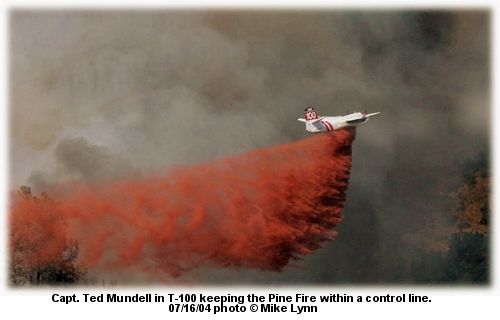
CNN reported that about 500 residents were returning home to Lake Hughes and Elizabeth Lake when winds drove the fire away from their communities, but hundreds more remained displaced.
The fire's destroyed three houses, seven outbuildings, and a motor home. It's just under 45 percent contained, and firefighters are concerned that shifting winds could change the direction of the fire again.
According to CNN reports, the fire jumped three firelines in three days, and fire managers say winds could push the fire over a ridge into the city of Lake Hughes, about 30 miles north of Los Angeles.
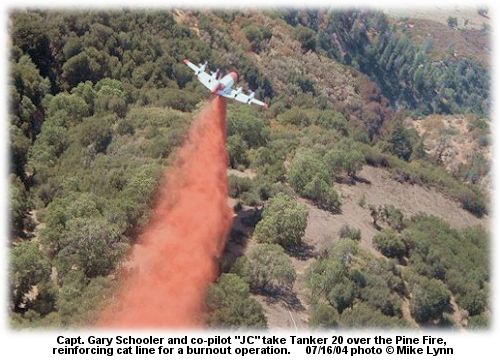
NBC4-TV reported that mandatory and voluntary evacuations are in effect for Lake Hughes, Elizabeth Lake, Baldwin Grade Canyon, Pine Canyon, Meenach, Three Points, Tweedy Lake, Portal Ridge Road and Kings Canyon Ranch. The Red Cross has set up shelters in Lancaster.
About 1,800 federal, state, and local firefighters on the fire.
A Sacramento Bee report said officials are searching for an arsonist suspected of setting the fire.

PARTYING TEENS MAY HAVE STARTED NEVADA FIREJULY 17 -- CARSON CITY, NV: Firefighters saved more homes from burning yesterday on the 7,566-acre Waterfall Fire near Carson City, and investigators are thinking that partying teenagers may have caused the fire.
Helped out by slightly cooler and less gusty weather, airtankers and helicopters dumped millions of gallons of water and retardant on the wildfire, according to the Sacramento Bee, and crews were trying to keep the fire from burning into two woodland residential areas -- Lakeview and Timberline.
"We are trying to keep the fire from burning into Lake Tahoe State Park and Washoe County," said Pat Irwin with the Sierra Front Interagency Dispatch Center. "The aircraft are pounding the northwest corner of the fire."
The fire started early Wednesday in a scenic canyon that is a popular party spot for local youths. The area has no legal fire pit, and it's the source of about 100 law enforcement calls every year. Carson City Sheriff Kenny Furlong said officers last week arrested several people who were lighting fireworks near the waterfall there. Now, officials are trying to find as many as 20 teens reported in the area just before the fire was ignited.
Scores of evacuated residents tried to return to their neighborhoods yesterday; some found only rubble and ash. At the entrance to one neighborhood, sheriff's Deputy Jarrod Adams spent most of the day saying no to people who wanted to return to homes still threatened by flames. "It's a drag telling people, 'I don't know if you have a house, and you can't look at it,'" he said.
One local man was arrested Friday after driving past a barricade and scuffling with a deputy who tried to stop him from reaching his home.
The fire was about 50 percent contained last night. Martin's Type 1 team is on the fire, about three miles west of Carson City. Extreme fire behavior was a problem yesterday, with torching and spotting up to a quarter mile.
The fire's about 20 miles south of Reno and eight miles from the rim of Lake Tahoe. Fourteen homes, one commercial building, and 25 outbuildings have burned, and 1,000 homes, 75 commercial buildings, and 100 outbuildings are still threatened. More than 1,900 firefighters, 123 engines, and 26 aircraft are on the fire.

YOSEMITE TOURISTS CLOAKED IN SMOKEJULY 16 -- LEBEC, CA: The Meadow Fire in Yosemite National Park continued to spread yesterday, closing popular trails, filling the valley with smoke, and showering coatings of ash onto parked cars.
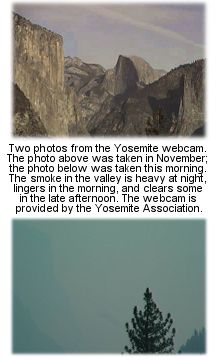 "It looks pretty cloudy and dark around here, not like it does on the postcards," said Sam Burgess, an 11-year-old tourist from Sydney, Australia, who was camping with his parents. "It looks pretty cloudy and dark around here, not like it does on the postcards," said Sam Burgess, an 11-year-old tourist from Sydney, Australia, who was camping with his parents.
The fire was at 1,700 acres yesterday, and crews made progress building fireline along the north and west flanks. Smoke is still thick in the night and early morning hours in Yosemite Valley.
KCRA-TV reported that the fire almost doubled in size in the past 24 hours, and was estimated this morning at 3,000 acres.
Crews are working to contain the fire on its northern and western sides, but the fire's being allowed to burn toward the south and east for resource benefits in those areas.
The San Francisco Chronicle reported that the road to Glacier Point was closed, along with hiking trails to Half Dome and Little Yosemite Valley. The Four Mile Trail from the valley floor to Glacier Point and the backpackers' camp at Little Yosemite Valley also are closed.

NEW WASHINGTON FIRE BURNS 900 ACRESJULY 16 -- LEAVENWORTH, WA: A lightning-lit fire yesterday west of Leavenworth had grown to 900 acres by evening, burning in the Icicle Creek drainage of the Washington Cascades. The Seattle Post-Intelligencer reported that Chelan County sheriff's deputies were contacting people in campgrounds, advising them of the fire, and giving them an opportunity to leave.
The Icicle Fire was ignited at an elevation of about 5,000 feet and was moving downhill. KIRO-TV reported that the fire is burning in ponderosa pine and light grass and that two helicopters are on the fire today.
The Seattle Times reported that three lightning strikes ignited three fires around 4:30 p.m. and that by early evening the fires had merged on the south side of Icicle Road. Firefighters think the fire may jump to the north side of the road.
The Northwest Coordination Center reported this morning that there are cabins and campgrounds in the area, and a Level 2 evacuation alert is in effect, advising residents in the area to leave the area. Bennett's Type 1 team is committed.

CALIFORNIA FIRE CHASES
600 FROM THEIR HOMESJULY 16 -- LEBEC, CA: A 10,290-acre wildfire is threatening rural communities on the edge of the Angeles National Forest and has forced 600 people to evacuate. Mandatory and voluntary evacuations are in effect for Lake Hughes, Elizabeth Lake, Baldwin Grade Canyon, Pine Canyon, Meenach, Three Points, Tweedy Lake, Portal Ridge Road and Kings Canyon Ranch.
More than 200 teenagers were evacuated from two Los Angeles County juvenile probation camps yesterday afternoon when the fire burned to within a couple miles. They were transported to a camp in Lancaster.
The Pine Fire was at 40 percent containment last night. A unified command has been established between Gelobter's Type 1 team and the L.A. County Fire Department. The fire's burning in heavy brush southeast of Lebec.
The San Diego Union-Tribune reported that the fire destroyed at least one motorhome and a building since it started Monday. Two firefighters suffered heat-related illnesses, and another was killed earlier this week in a vehicle crash as he drove home from the fire.
Smoke from the fire drifted 60 miles to the south, and the Los Angeles County Department of Health Services issued an "extreme caution advisory" for people with heart and respiratory ailments.

FIREFIGHTERS AND REPORTER
INJURED ON NEVADA FIREJULY 15 -- CARSON CITY, NV: The Waterfall Fire burned at least six luxury homes to the ground yesterday and advanced to within a half mile of the governor's mansion. The fire, zero percent contained last night at 2,000 acres, is on the Humboldt-Toiyabe National Forest about three miles west of Carson City.
Erratic winds drove the fire in all directions throughout the day, evacuating subdivisions along the west side of Carson City. Voluntary evacuations are in effect in other areas.
Four firefighters and a television reporter were injured, according to an ABC news report; ten other homes, businesses, and outbuildings were destroyed, and about 550 more were threatened.
Scheuerman's Type 2 team is on the fire, and Martin's Type 1 team has been ordered. The fire's burning in timber with litter understory and brush, and extreme fire behavior was a problem. The fire was reportedly started early yesterday morning by a person near a waterfall on a creek popular with local youths.
U.S. Highway 395 was temporarily closed, and firefighters had to pull away from homes in some areas because of the intensity of the fire. Scott Huntley with the Sierra Front Interagency Dispatch Center said winds were gusting to 30 mph.
One firefighter broke a leg, another suffered back and neck injuries, and two others were burned. One of the burned firefighters was with a crew trapped briefly when the fire overran their position and destroyed their engine. Reporter John Tyson of KOLO-TV in Reno suffered minor burns on his hands and face. His vehicle was destroyed, along with an ambulance.

8,500-ACRE CALIFORNIA FIRE
STARTED BY BOTTLE ROCKETSJULY 14 -- SAN DIEGO, CA: An incoming weather system might help firefighters who are fighting a huge fire that took off yesterday in the mountains near Lake Henshaw. More than 1,200 firefighters were working in 90º weather this afternoon, on a fire that's burning in steep, mostly inaccessible terrain; the National Weather Service forecast includes a flash flood warning for the mountains and deserts that's in effect until 8 p.m.
The Mataguay Fire is south of Ranchita burning in chaparral and grass. It began as three separate blazes along state Route 79 just after noon yesterday, according to the San Diego Union-Tribune. A Border Patrol agent and a state Fish and Game warden came upon the first fire and tried to put it out, then saw a second small fire about 300 yards north of them and tried to put that one out too. But both were spreading too quickly. A third fire was found about 1½ miles to the north.
All three were "maliciously set with bottle rockets," according to CDF Battalion Chief Mike Neill.
Winds pushed the fire to the east, threatening the Mataguay Boy Scout Camp. Firefighters and sheriff's deputies decided to evacuate the camp, but decided the exit road was too hazardous. People at the camp were sheltered there, then sent in a convoy to a high school about eight miles away.
The fire was almost 70 percent contained this morning and full containment was predicted for this evening.
Four firefighters incurred minor injuries.
The fire destroyed two outbuildings yesterday; residents evacuated from Ranchita were allowed to return home last night.
Crews on the fire were assisted by four airtankers, seven helicopters, 10 bulldozers, and seven water tenders. The Mataguay Fire is the largest in the county since October's devastating Cedar fire, which killed 15 people, burned 273,000 acres and destroyed more than 2,000 homes.

FIRE SMOKES UP YOSEMITEJULY 14 -- RENO, NV: A fire that was ignited by lightning two weeks ago in the southern part of Yosemite National Park grew from 200 acres to over 1,300 acres yesterday, putting up smoke that was visible from Reno. Tom Nichols, fire management officer at the park, said the fire started south of Glacier Point and has thus far been allowed to burn. The Meadow Fire was at 30 acres Sunday, but low humidity and an early snowmelt contributed to yesterday's rapid growth.
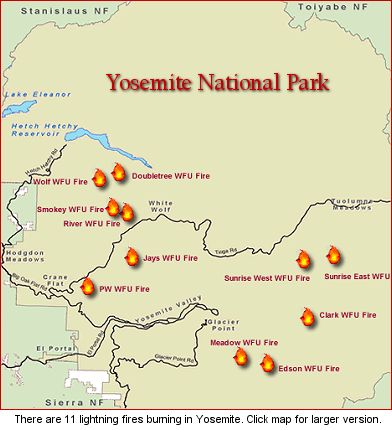 The park has 51 firefighters and one helicopter on the fire, according to the Reno Gazette-Journal. A Fire Use Management Team has been ordered, along with two hotshot crews, two Type 2 crews, a Type 3 strike team, and another helicopter. The park has 51 firefighters and one helicopter on the fire, according to the Reno Gazette-Journal. A Fire Use Management Team has been ordered, along with two hotshot crews, two Type 2 crews, a Type 3 strike team, and another helicopter.
The fire is burning in red fir and lodgepole seven miles southeast of Yosemite Village.
Park Superintendent Michael Tollefson closed Glacier Point Road, and backpackers in the Little Yosemite Valley might be asked to leave the area. Visitors can call (209)372-0200 for current status of the Glacier Point Road. All trails and trail junctions entering the wilderness on the Glacier Point Road heading to Lower Merced Pass and the Buena Vista Lakes area have been closed, along with Mono Meadow Trailhead, the Panorama Trail between Glacier Point and Nevada Fall, the John Muir Trail above Nevada Fall to Little Yosemite Valley and Half Dome, Four Mile Trail, the trail between Bunnell Cascades and Little Yosemite Valley, trails between Sunrise Lakes and Little Yosemite Valley (junction at Clouds Rest), and trails between Cathedral Lakes and Little Yosemite Valley area. For current updates on closures, call (209)372-0491.
The Little Yosemite Valley Backpackers Campground was evacuated today as a precautionary measure.
The fire's being managed for resource benefit and won't be actively suppressed unless it burns out of designated boundaries. Aggressive containment action will be taken, however, on the northern flank to prevent further spread toward the Glacier Point Road and the Yosemite Valley southern rim.
The U.S. Forest Service in California recently suspended "wildland fire use" or management of a fire for resource benefits, but the National Park Service has not done so. Fire use is a key part of management at Yosemite; there are currently 11 active lightning-ignited fires burning in the park. There's a live view of Yosemite Valley online courtesy of the Yosemite Association.

CALIFORNIA RESIDENTS EVACUATEDJULY 13 -- PALM SPRINGS, CA: Wildfires that have burned over 8,400 acres have forced the evacuation of dozens of homes in southern California, along with two campground evacuations near Palm Springs.
Soaring temperatures and dry conditions are making the firefighting difficult; three firefighters suffered heat exhaustion yesterday on a 5,000-acre fire on the edge of the San Bernardino National Forest. The Verbenia Fire, currently managed by McCormick's Type 2 team, is 10 miles northwest of Palm Springs, burning in grass and chaparral. It was 25 percent contained last night at 4,000 acres. Temperatures in the Riverside County area are expected to top 100 degrees today, according to an AP report.
The Gatos Fire northwest of Coalinga is at 750 acres, and the Peterson Fire northeast of Fresno was at 150 acres last night. Extreme fire behavior was a problem yesterday on both fires.
Southeast of Lebec, the Pine Fire is burning in heavy brush, also with extreme fire behavior. It was 20 percent contained last night at 300 acres.
ABC news reported that the Peterson Fire is threatening homes and forcing evacuations near Shaver Lake. Firefighters hope to have the fire contained later today, but said a change in weather could push the fire out of control. The fire was accidentally ignited by a homeowner using welding equipment, according to CDF personnel.
The Desert Sun reported that the Verbenia Fire above Snow Creek Village had more than 800 firefighters on it. "Firefighters won the battle for Snow Creek Village in the back yards and side roads of the community Sunday night," said the report. "But temperatures that reached 110 degrees, thick clumps of tinder-dry brush and near-zero humidity fed the fire that leaped to 5,000 acres on its march up Fuller Ridge."
Winds that frustrated firefighters also pushed layers of thick smoke into the Coachella Valley, prompting calls to the Palm Springs Aerial Tramway.
"We’ve gotten a few calls regarding it -- whether we would shut down or not -- but we’ll keep operating as long as it’s safe," said Lena Zimmerschied, the tramway’s public affairs manager.
The tramway has a live webcam online.
Riverside County fire and federal hotshot crews joined state inmate crews and engines from Redlands and Hemet, Orange County, and Los Angeles County. Mic Bernal, who runs an inmate crew based Palmdale, said two of his men had to be carried off the ridge, overcome by the heat.
"We’ve got crews on top trying to get an anchor on it," he said. "But it made a run up the canyon and got enough ash that it jumped the other side. It was just flash fire."
In northern Los Angeles County, a 3,400-acre fire near Lake Hughes on the Angeles National Forest was 20 percent contained early today. That fire caused the mandatory evacuation of 10 homes in the Happy Valley area shortly after midnight. Another two dozen homes nearby were on voluntary evacuation earlier yesterday.
The fire had burned into thick forest that hasn't burned in 75 years, according to the county fire department.

OLTROGGE'S TEAM HANDING OVER NUTTALLJULY 13 -- SAFFORD, AZ: Firefighters are still hunting down hot spots along the perimeter of the Nuttall Complex southwest of Safford, and mop-up and rehab are under way on the fire, which is 75 percent contained.
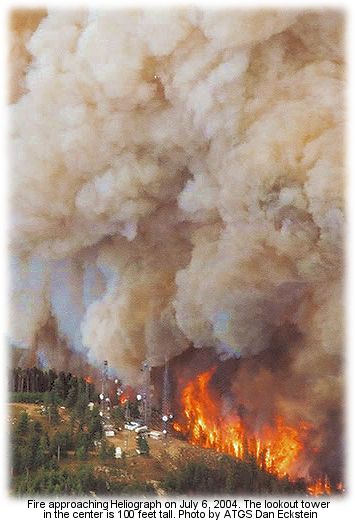 Oltrogge's Type 1 team will hand off the complex to Winchester's Type 2 team this evening. Oltrogge's Type 1 team will hand off the complex to Winchester's Type 2 team this evening.
Light afternoon rains fell over much of the fire area yesterday; Eric Peterson, a meteorologist assigned to the incident, said most of the precipitation was south of the burn area, and hail fell near Clark Peak.
The most intense fire behavior was within the fire’s perimeter in the Heliograph Peak area, where less rain has fallen and the higher humidity levels have not been as effective at tempering fire activity. Fire burned through the Heliograph Peak area on July 6, damanging some structures and compromising communications functions.
Most of the observed fire behavior yesterday was minor surface spread, with the fires creeping and smoldering. The most intense burning occurred in heavy logs and stumps.
The incoming Type 2 team will reassess the opening of the Swift Trail Road (U.S. Highway 366) and associated developed areas. Nearly 700 personnel are still on the fire, including 12 hotshot crews, six helicopters, 20 engines, 16 water tenders, and four dozers.
The complex includes the Nuttall Fire, started by lightning on June 26, and the Gibson Fire, which was ignited by lightning on June 22. The complex is at 29,200 acres today; it destroyed one structure and damaged another. Firefighters sustained 28 injuries during the course of the fire; most were heat-related illnesses.
Oltrogge's team has an excellent incident website online, including photo galleries, progression maps, and even an airtanker slide show.

MEDICAL HELICOPTER CRASH KILLS FOURJULY 13 -- COLUMBIA, SC: A medical helicopter transporting a woman injured in a minor accident crashed early this morning in South Carolina, killing her and the three crew aboard. The crash occurred about 6 a.m., according to an AP report, in a heavily wooded area just off Interstate 26. Besides the injured passenger, the pilot, a flight nurse, and paramedic were also killed.
Newberry County Emergency Medical Services had requested the helicopter for a pedestrian who was reportedly injured in a minor hit and run at a rest stop. A state trooper and a truck driver watched the helicopter take off.
"When it got above the trees, we heard a boom and we didn't see it again," said trucker Johnny Williamson. The helicopter was found about a mile from the road in a wooded area on U.S. Forest Service land. The National Incident Notification Network reported that foggy conditions were present across much of the area this morning, but it wasn't known whether fog was a factor in the crash.
Investigators from the NTSB and FAA are en route.

CREWS STRUGGLE IN HEAT ON FIRE NEAR PALM SPRINGSJULY 12 -- PALM SPRINGS, CA: Steep terrain and high temperatures are making it difficult for firefighters to contain a fire that started yesterday afternoon in the Cabazon area; the Verbenia Fire was about 40 percent contained this morning at 1,500 acres.
Last night the fire was holding at 400 acres, with three airtankers, two helitankers, and seven helicopters assigned. The sandiegochannel.com reported that temperatures early this morning were nearing 90º and winds were gusting to 23 mph. Predicted high for today was 113º and early this afternoon Palm Springs reported 107º with RH at 25 percent.
More than 360 firefighters were on the fire in the Snow Creek area at the edge of the San Bernardino National Forest near Palm Springs.
The Gatos Fire northwest of Coalinga was zero percent contained last night at 400 acres. Containment was expected for today, despite extreme fire behavior caused by high temperatures and low relative humidity.

WILDFIRE SERIES BEGINS TONIGHT
ON THE WEATHER CHANNELJULY 12 -- ATLANTA, GA: From lightning to drought to Santa Ana winds, firefighters know that the weather is a major factor affecting wildfires and fire behavior. Starting tonight on the Weather Channel, TV viewers who aren't firefighters will learn about how weather influences wildfires.
The special weeklong series, "Wildfires: Forecasting the Flames," looks at the wildfire situation in the Western United States. Hosted by Heidi Cullen, climate expert for the Weather Channel, the series examines ongoing drought in the West and the forecast for the 2004 wildfire season. The programs explain challenges and dangers faced by those who fight fire, and tells viewers how to help prevent wildfires.
The five-part series is scheduled to air hourly during the network's primetime program "Evening Edition" between 9 p.m. and 11 p.m. Eastern time.
A different program airs each evening. Tonight's program looks at drought, and features staff from NIFC discussing fire potential and the season forecast. Tuesday evening's program features a homeowner who helped battle flames to save his house and outlines defensible space for homeowners. On Wednesday, the program will be geared toward campers and hikers with campfire safety and other forest safety items. Thursday's show features smokejumpers from McCall, and on Friday the jumper series continues with fire behavior and how firefighters monitor and react to weather.

WINDS EXPECTED ON POT PEAK FIREJULY 10 -- CHELAN, WA: The winds came from the west earlier this week on the Pot Peak Fire, and crews knew this would not be an easy fire. At 8,300 acres this morning, the fire's 45 percent contained. Lohrey's Type 1 team is on the fire, along with more than 830 personnel, 23 engines, four dozers, 18 tenders, and ten helicopters. The cold front that dropped summer showers on Seattle earlier this week became was an annoyance to firefighters, according to the Seattle Times.
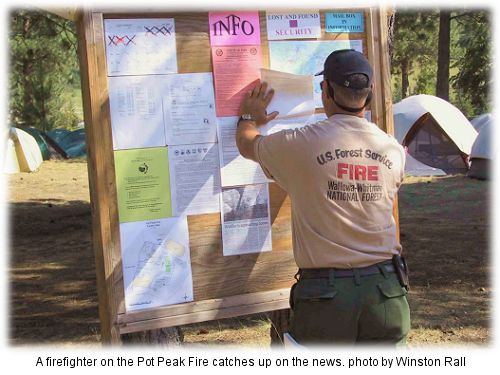
Information Officer Mikey Ferris said the fire would likely grow to 17,000 acres before it's contained, and would probably smolder till the first snows. "But it would be a lot more expensive if it ran down to the lake and burned up the expensive homes," Ferris said.
Kurt Dykema, 34, a Baker River Hotshot from Skagit County, said the maze of steep ravines and hidden washes that define the landscape have made this fire a challenge.
"This fire is just swirling around," he said. "So I can't tell you what it's going to do next, because I don't know what the wind is going to do. There's no two fires alike." Burnout operations were finished yesterday along the North Fork of Twentyfive Mile Creek, and mop-up is progressing well on the eastern half of the fire.
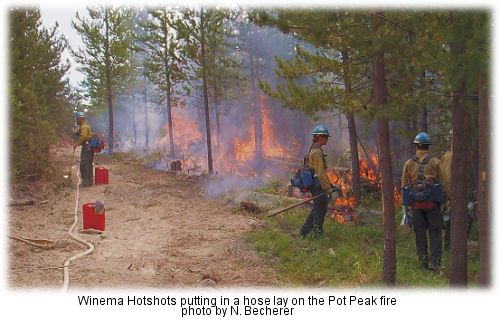
Southwest winds with gusts to 16 mph and thunderstorms this afternoon are expected to test firelines on the northwest portion of the fire. The fire's expected to move west along Pot Peak Ridge south of North Fork Twentyfive Mile Creek. Mop-up and rehab are under way on most sections of fireline. Today's forecast included breezes of 4 to 8 mph with gusts to 12 mph increasing to 10 mph with gusts to 16 mph late in the day. Crews were cautioned to expect gusty and erratic winds if thunderstorms come through. A 30 percent chance of showers and thundershowers is predicted for the evening, with decreasing clouds after midnight.

TANKERS FLYING IN COLORADOJULY 10 -- CRAWFORD, CO: Firefighters worked to protect homes from a 400-acre wildfire burning yesterday on the Western Slope; about five houses were within a quarter mile of the Saddle Mountain Fire in southeastern Delta County, and a dozen more were within a mile of the fire.
The fire yesterday made a major run with erratic fire behavior before the north and south peaks of Saddle Mountain. Crews reported zero night-time humidity recovery because of a thermal belt.
KUSA-TV reported that three airtankers worked initial attack on the fire and kept the flames from nearby homes. Along with four SEATs and two helicopters, pilots put 80,000 gallons of fire retardant out yesterday.
The Montrose Daily Press called it a "massive air assault."
"The fire originated fairly close to at least one house," said Steven Hall with the BLM. "Areas that burned are within 100 yards of one house. If the fire came down off the mountain we could definitely have some homes in serious danger."
The fire started Thursday on private land, according to the Rocky Mountain News, and then spread into the Gunnison National Forest. About 80 firefighters were on the fire, along with six engines, three heavy airtankers, and two helicopters.
Crews have got the fire about 10 percent contained but it's expected that they'll be pulled off the lines later today because of afternoon thunderstorms. Dispatchers reported yesterday that clouds were starting to roll into the northern part of Wyoming. Staff at the Rocky Mountain Coordination Center are predicting scattered thunderstorms across southeast Colorado, Kansas, Nebraska, and South Dakota, with isolated dry storms over western and northern Colorado and the Black Hills of western South Dakota. The strongest winds should remain over the plains, ranging from 10 to 30 mph.
Vinyard's Type 3 team is on the fire and a Type 2 team has been ordered; they're expected to take over the fire today. The Grand Junction Sentinel reported that an area resident who was burning brush in violation of a county fire ban has been contacted by the Delta County Sheriff’s Office as a possible suspect in causing the Saddle Mountain Fire.
Information Officer Pam Wilson said fire behavior was pretty quiet this morning.
"I would say it is kind of smoking and smoldering," she said. "The airtankers and the helicopters that worked yesterday did an outstanding job of cooling this fire down."

WILDFIRE VICTIMS QUESTION INSURANCE COST CALCULATORJULY 10 -- SAN DIEGO, CA: Don Robinson says his Residence Mutual insurance policy pegged the cost of replacing his San Diego home at $233,000. But after a southern California wildfire destroyed his four-bedroom house last year, a contractor told him it would cost $460,000.
Hundreds of other homeowners are also finding their coverage was inadequate, according to an AP report; industry critics and attorneys suing on behalf of homeowners figure that insurance agents are misapplying software that estimates the replacement cost on a home. One software program put the cost of replacing Robinson's home at $249,000, but a more detailed questionnaire estimated $427,000.
Critics say insurance agents may be writing policies using the quick survey, which requires a ZIP code, year of construction, square footage, and a few other questions. A more detailed survey taking into account higher valued assets of the home produces more accurate estimates.
The California Insurance Commissioner's office is studying the use of the calculators in its investigation of complaints by victims of last year's fires. Underinsurance accounted for 219 of 445 complaints the office had fielded as of June 28. After hearing dozens of complaints in April at homeowner meetings in San Diego and San Bernardino counties, Insurance Commissioner John Garamendi said agents may have deliberately lowballed replacement cost to sell more policies.
Peter Moraga of the Insurance Information Network of California said it's really up to the homeowner to ascertain whether the coverage is enough.
"If used properly, the software can spit out pretty accurate numbers," said Jerry Ramsey, a Los Angeles attorney who has sued on behalf of 30 homeowners and plans about 20 more lawsuits, including one seeking class-action status against Farmers Insurance Co.
Underinsurance is a problem that surfaces after nearly every major natural disaster. One survey found 64 percent of U.S. homes were underinsured by an average of 27 percent last year.
About 600 State Farm policyholders lost their homes in last year's fires; between 40 and 50 have complained to regulators about being underinsured. Insurance industry officials point out that replacement costs often skyrocket after major disasters. "You have such a demand surge in catastrophes like these that a contractor can charge $300 a square foot when he charged $150 the day before," said Paul Rubicam with Residence Mutual Insurance Co.

NORTH LAKE TAHOE INSPECTING DEFENSIBLE SPACEJULY 09 -- INCLINE VILLAGE, NV: The North Lake Tahoe Fire Protection District's volunteer defensible space inspection program has had a tremendous response from the community, and Battalion Chief Greg McKay says it's been so successful that they're getting a little behind schedule.
"It's great to see so many concerned people," McKay said. "But we're getting backed up because so many condo and homeowner associations are signing up."
The North Lake Tahoe Bonanza reported that 150 property owners signed up, but the number of multi-unit properties involved pushes the inspections into the hundreds. McKay said a single family home usually takes less than an hour to inspect, but multi-unit properties such as condominiums can take half a day.
The checklist used by the fire district includes 14 items that the inspector answers with a "yes" or "no." McKay said a lot of residents have done well with defensible space, with some properties needing only one or two modifications in order to pass. Items on the checklist range from the type of roofing material to locations where firewood is stored. Landscaping items such as shrubs and mulch are also checked.
The inspections are voluntary, but the fire district may make them mandatory.
For more information, call the NLTFPD at (775)831-0351.

SITUATION HEATING UP IN PHOENIXJULY 08 -- PAYSON, AZ: Wildfires in Arizona may force rolling blackouts in Phoenix and other parts of central Arizona, with fires threatening major transmission lines. Temperatures above 100º could be a major problem today in Phoenix, because two high-voltage lines that carry power into the Phoenix area run through fire areas in northern and central Arizona.
Phoenix's Valley of the Sun is still suffering from an unrelated weekend fire that destroyed transformers at a major switching substation.
"We are very close to the situation where the power available in the Valley will not meet the power demand," Gov. Janet Napolitano said. "They're running right up against the margin."
The Arizona Daily Star reported that central Arizona homes and businesses may lose power temporarily between 4 p.m. and 7 p.m., when utilities face their highest summer demand. Phoenix expects a high of 106º today and 109º over the weekend. Napolitano urged people to curb power usage during those peak hours, avoid use of large appliances, and turn up their thermostats.
The Arizona Republic said today and Friday are make-or-break days for the Valley's weakened power grid. Utility officials say they will know by about 2 p.m. if they should prepare for rolling blackouts. Peak power use typically occurs late in the workweek. So far, crews have kept fires near Payson and Flagstaff away from powerlines, but if either line went down during peak demand, blackouts could occur.
On July 4 a fire at a power substation near Sun City shut down one of four entry points for electricity coming into the Valley, effectively cutting the power supply by 20 percent. The fire is under investigation and was likely arson-caused. Arizona Power Service (APS) is working on restoring one of three banks of damaged transformers and has located a transformer in another state that could be moved to the Valley. That would allow a second bank of transformers to power up.
Both APS and Salt River Project -- the state's second-largest power provider -- say they would cut power to one area of the Valley for 20 minutes to an hour. After power was restored to the first area, another neighborhood would be taken off line, and so on. Hospitals, prisons, 911 call centers, and other emergency facilities would not be affected by rolling blackouts.
A new fire yesterday, the 90-acre Ponderosa Fire, forced evacuation of the two Thompson Draw subdivisions east of Payson, along with a summer camp. The fire was fully contained last night and residents were allowed back. The fire was close to Tonto Village and a power utility line. Another APS line did burn, causing loss of power and telephone use from Highway 260 through several communities.
Officials closed a 45-mile stretch of Arizona 87, the Beeline Highway, between Phoenix and Payson so that fire crews could conduct burnouts between the road and the 94,300-acre Willow Fire near Payson. The Department of Public Safety expects to reopen the highway early today.
Firefighters successfully defended a large powerline about 10 miles southeast of Flagstaff. The 14,600-acre Jacket Fire was ignited by lightning June 22; the fire from the burnout caused smoke that could affect visibility on Interstate 40.

EXPLODING MREsJULY 07 -- BOISE, IDAHO: Forest Service safety managers have issued a safety alert warning about explosion hazards associated with MREs (Meals Ready-to-Eat) and specifically, the food heating device found in hot meal packets. The Flameless Ration Heater (FRH) is developed by using hypercorrsoion of a magnesium-iron alloy. The FRH is packaged with every MRE. If the MREs are exposed to fire and the magnesium powder ignites, a class D fire will occur, exhibiting sparking and flare-up if sprayed with water.

If the plastic pouch containing the FRH melts, adding water to the magnesium-iron compound can cause the production of hydrogen, and if that accumulates in a confined space, the fire can intensify and an explosion may occur.
Cache managers were warned that if the FRH continues to smoke or sizzle after the flames are out, hydrogen is being produced and poses a respiratory hazard. If the magnesium becomes involved, neither foam nor water should be used to extinguish the MRE.
Warehouses with large quantities of FRH pallets in storage should protect the cases from physical damage and from water in any form, including leaks, snow, rain, or flooding. Damaged cases should be handled with particular care since they are more vulnerable to activation by water. Equipment for fighting Class A and Class D fires should be available, and proper ventilation should be provided so that hydrogen will not build up to an explosive concentration.
The safety alert also recommended that training be provided to local fire services in fighting combined Class A and Class D FRH fires. Appropriate warning labels should be placed on the exterior of the case and should be visible when cases are stacked on a pallet.
Unused MRE heaters are considered a hazardous waste by the EPA, and must not be disposed of in the regular trash. They should be recycled through the Defense Re-use and Marketing Office (DRMO) or other qualified recycling program. Unused heaters can also be activated as per manufacturer's instructions and then disposed of as ordinary garbage.
Collecting and storing unused MRE heaters when the real intent is found not to be reuse as an MRE heater is a violation of federal law.
Questions should be directed to your local/regional Hazardous Materials Coordinator or to Gary Hoshide at (406)329-1029 or Allison Good at (202)205-2934.
The complete 3-page safety alert is available online as a 192k PDF document.

POT PEAK FIRE GROWINGJULY 06 -- CHELAN, WA: Firefighters deepened burnout areas on the Pot Peak Fire yesterday, using aerial ignition on the northern end of Slide Ridge south to Slide Peak. Burnout operations continued from Slide Peak toward Stormy Mountain, and crews started burning out in the area of the confluence of Darby Draw and the North Fork to create a fire-safe boundary for structures in Twentyfive Mile Creek and along the southern shore of Lake Chelan.
The Pot Peak Fire is not threatening the community of Chelan or recreation use on Lake Chelan, and all businesses are open to visitors.
The main fire, about 15 miles west of Lake Chelan, will continue to back down toward the North Fork of Twentyfive Mile Creek, according to Lohrey's Type 1 team, which is managing the fire. On the south end, the fire is advancing on Slide Ridge. Heavy fuels in the burnout areas in the northeastern area of the fire are causing the fire to back down the ridge at a rate of 10-15 feet per hour. Helicopters are dropping water and retardant to cool the leading edges of the fire.
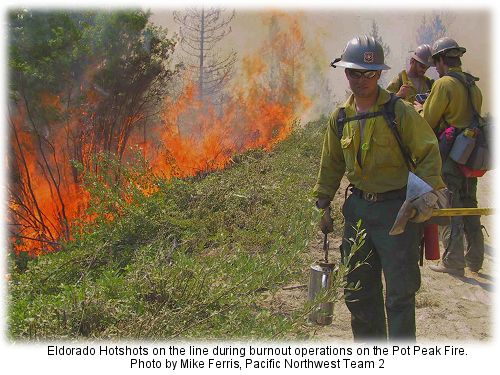
The fire was ignited by lightning on June 26 and is now about 35 percent contained at 6,550 acres. Almost 900 personnel are on the fire, along with 26 engines, five dozers, 19 tenders, and a dozen helicopters.
KOMO-TV reported that Douglas County sheriff's officials advised people who live near the Beebe Bridge Fire, east of the lake and the Columbia River, to evacuate after strong winds pushed the blaze a half mile north overnight. The fire covered about 3,000 acres -- up from 2,000 the day before -- and was burning about a quarter mile from some homes. The Beebe Bridge fire was started by an owl with a chicken.
A cold front is expected to bring strong winds over the fires this afternoon. Winds are expected be 6 to 10 mph from the west-northwest with gusts to 10 mph. Clouds should increase this afternoon, with a 30 percent chance of showers.

BOOK REVIEW:
JACK WARD THOMAS:
The Journals of a Forest Service ChiefJULY 06 -- MISSOULA, MT: In the summer of 1986, Jack Ward Thomas began keeping a journal. "This will be a journal of random thoughts," he wrote. "My purpose is unknown to me, but I feel a compulsion to begin. Perhaps it will serve as a tickler of memory for the book I intend to write, but of course never will."
This first book from Jack Ward Thomas is sure to open the eyes of those who think they know how policy and management decisions affecting the nation's forests are made. Though Thomas has authored well over 400 publications, mostly on wildlife conservation, perhaps the most valuable thing he's written is the set of journals he started eighteen years ago - the book he intended to write.
As Chief of the Forest Service, Thomas is quick to give credit to those he respects, particularly his agency employees in the field. But he doesn't shy from battle, and his assessments of some political appointees in Washington and certain members of Congress are brutal.
 Thomas was drafted into the chief's job shortly after Clinton took office, and he took the helm of the agency with typical fortitude - and the naiveté of a researcher thrust into the political cauldron that is Washington DC. Thomas was drafted into the chief's job shortly after Clinton took office, and he took the helm of the agency with typical fortitude - and the naiveté of a researcher thrust into the political cauldron that is Washington DC.
"We don't just manage land," he wrote, "we're supposed to be leaders. Conservation leaders. Leaders in protecting and improving the land."
Statements like that surprised some of the people in Washington, but certainly didn't surprise his longtime friends and colleagues. Thomas had been talking about and writing about conservation for most of his life. And the cream of that conservation writing is in his journals. This book offers not only insight into the mind and heart of a naturalist, but also a perspective on the politics of natural resource management through the eyes of one of this country's finest conservationists. His writings clarify many of the environmental issues we face today: protecting obscure but endangered species, dealing with wildfire and wildfire fatalities, balancing resource needs against the need to preserve, and the development of policies to address forest health.
This book's a treasure, and will be a valuable addition to the collections of those who care about natural resources management.
The first edition of the book sold out in less than a month. You can order a copy at amazon.com or from your local bookseller.

TANKERS WORKING ARIZONA FIRESJULY 06 -- SAFFORD, AZ: Two of Aero Union's P-3 Orions bought fire crews some extra time yesterday afternoon when they dropped loads of retardant in front of the advancing Gibson Fire on Mt. Graham.
"It was nice to have them back," said Incident Commander Dan Oltrogge. "We like to have all the tools we can."
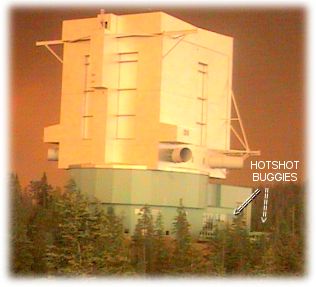 Oltrogge's team is managing the Nuttall Complex; the Tucson Citizen reported that it's burned 16,360 acres in the Pinaleño Mountains. The Gibson Fire is threatening the Mount Graham International Observatory. Oltrogge's team is managing the Nuttall Complex; the Tucson Citizen reported that it's burned 16,360 acres in the Pinaleño Mountains. The Gibson Fire is threatening the Mount Graham International Observatory.
The fire came within three-quarters of a mile of the observatory Saturday but did not progress any further, according to the Eastern Arizona Courier.
Dr. John M. Hill, director of the Large Binocular Telescope Project, said he was a little nervous as the flames approached the observatory Saturday, but he was more optimistic by Monday.
"Today seems a little better than Saturday," he said. "I feel a little better every time I look at the web cam and see the little green buses for the hotshot crews in front of the building."
Alex Stone, director of air operations on the team, said the tankers had already dropped retardant on the Willow Fire near Payson and made six runs on the Nuttall Complex before flying to a new fire on the Gila National Forest yesterday. The airtankers, along with a dozen helicopters, have been supporting 22 ground crews working to protect the observatory and the mountain communities of Columbine and Turkey Flat.
Rick Kvale, aviation officer, said the fire area includes near-vertical slopes up to 90 percent. "That's too steep to put firefighters in," he said.
Oltrogge said about 150 firefighters are working in the area immediately surrounding the observatory. They plan to connect existing roads by clearing land with dozers and then using the roads for firelines.
Three observatory employees remain atop Mount Graham with the $130 million telescopes. "The building's not going to burn, but the smoke and heat could do some real damage to the instruments inside," said Pruett Small, operations section chief.
When fully operational in 2005, the Large Binocular Telescope will be the world's most technologically advanced optical telescope. It is expected to yield images nearly 10 times sharper than those from the Hubble Space Telescope.

FIVE AIRTANKERS BACK ON DUTY, MORE PENDINGJULY 05 -- CHICO, CA: Five of the 33 airtankers canceled in May by federal firefighting agencies are back in the air, and several more are staged for approval.
"With only five of the tankers initially going back to service, it was a tough decision on where to station them," said Jo Simpson with the BLM in Reno. "They're being spaced out across the West to provide the best geographic coverage with limited availability."
The Salt Lake Tribune reported that the Forest Service was in the final stages of signing contracts for the five planes on Saturday. The current renegotiated contracts are for 90 days on the Aero Union P-3 tankers.
 There are no "home bases" for the current reincarnation of airtanker contracts; the home base for Aero Union's P-3s will be Chico, California. A letter of inspection from DynCorp to the Forest Service was delayed by holiday mail slow-downs, which has temporarily stalled the return to service of two more P-3's owned by Aero Union. There are no "home bases" for the current reincarnation of airtanker contracts; the home base for Aero Union's P-3s will be Chico, California. A letter of inspection from DynCorp to the Forest Service was delayed by holiday mail slow-downs, which has temporarily stalled the return to service of two more P-3's owned by Aero Union.
Five of Aero Union's airtankers left yesterday, though, for their initial assignments. Tanker 22, piloted by Dean Talley, was sent to Cedar City, Utah. Captain Bill Waldman will be piloting Tanker 27 out of Winslow, Arizona, and Tanker 26 will fly out of Prescott, Arizona, with Greg Hock in command. Tanker 23 is initially based at Fox in southern California and piloted by Phil Darnell. Tanker 21 and Captain Jan Reifenberg will be in Fairbanks, Alaska.
Tanker 25 with Brent Conner in the cockpit will probably be sent to Moses Lake, Washington, and Gary Schooler will probably take T-20 to Battle Mountain, Nevada, as soon as they have the authority to fly.
Tanker 00 is still in the Aero Union shop in Chico, because maintenance on that P-3 was halted when the contracts were cancelled. That ship may be back up as soon as the second week in August.
Aero Union's package on the DC-4 aircraft is still in progress and could be approved in another month.
Fire managers in the areas where tankers will be initially deployed are grateful to have their heavy aerial resources back online. "Having a tanker stationed out of Battle Mountain will benefit all the wildland firefighting agencies in the Great Basin," said Kevin Hull, BLM chief of fire and aviation in Nevada. Arizona reportedly requested three of the five initially approved tankers, but will probably get just the two at Winslow and Prescott. If the southwest monsoons arrive soon, as is typical for mid-July, those aircraft could be quickly reassigned to other bases with heavier fire activity and more severe fire danger.
The Associated Airtanker Pilots (AAP), by the way, has an online store with caps, T·shirts, mousepads, postcards, and other cool stuff at cafeshops.com/wildfirenews/102588 and ALL PROCEEDS from that online store benefit the pilots' memorial fund.

AERIAL FIREFIGHTING COSTS UNCLEARJULY 04 -- PRESCOTT, AZ: Expenses for aerial firefighting are likely to increase this year, with federal officials estimating the cost at $66 million for supplemental aerial resources after canceling the heavy airtanker contracts in May. An internal agency plan estimated $1.3 million per two-week pay period for the Southwestern Region of the Forest Service to add seven medium and two heavy helicopters, eight SEATs, 20 smokejumpers, and two air tactical group supervisors to fill in for the loss of the heavy tankers this year.
Those figures don’t include the cost of flying, only of making the aircraft available. And, as the Prescott Daily Courier reported, that does not include the costs for the two military C-130 tankers stationed in Mesa. Those figures are calculated differently, because the feds have to cover the cost of lodging, meals, transportation, and salaries for two crews of about 30 personnel each.
"We don’t know what it’s going to cost until it’s all done," said Lt. Col. Rob Garza of the U.S. Northern Command.
The privately contracted heavy airtankers, on the other hand, come with crews of three, and contractors are paid for stand-by and flight hours.
The federal agencies figured they saved $20 million by canceling the $30 million tanker contracts, but expected to pay the contractors $10 million anyway.
Tanker industry owners have long complained that the Forest Service has been keeping them from updating their aircraft by keeping contract prices suppressed.
"For 50 years the agencies have been 'low-balling' their budgets in not just this arena but all areas, a point that was well-emphasized in the Blue Ribbon Panel Report," wrote retired aviation specialist Hugh Carson. "Part of the problem is that we have never had a leader that had the courage to stand in front of Congress and tell them the truth, i.e., that this is a highly complex, high-risk business that deserves first-class training, equipment and aircraft."
The Blue Ribbon Panel concluded that federal firefighting contracts ignore safety in the "widespread short-term pursuit of cost efficiency."
Congress added $500 million to this year’s $790 million firefighting budget to help stop the practice of raiding other accounts -- including forest restoration and fuels reduction projects -- to pay for firefighting, yet Forest Service program managers have already been told to spend whatever funds they have available in this year's budget as soon as possible because it's expected that their budgets will be raided for fire costs again this year.

COLORADO RESIDENTS EVACUATEDJULY 04 -- CEDAREDGE, CO: Evacuation notices were given yesterday afternoon to 129 Cedaredge residents threatened by a 2,000-acre fire on the south flank of Grand Mesa. The Grand Junction Daily Sentinel reported that the Red Cross set up a shelter for residents displaced by the McGruder Fire, which burned to within 200 yards of Cedaredge homes.
Mullenix's Type 2 team has been ordered.
It was one of four fires local officials were fighting yesterday. The 20-acre Tappan Fire burned south of Montrose, and north of Mesa County near Douglas Pass, firefighters were working on two fires that were ignited Friday afternoon. The Long Point Fire west of Barrel Creek was at 60 acres with two hotshot crews and four SEATs assigned.

SHELTER DEPLOYMENT ON NUTTALL COMPLEXJULY 03 -- SAFFORD, AZ: Crews are working to keep a 200-acre lightning-caused fire away from the Mount Graham International Observatory, home to some of the world's most powerful telescopes. The Tucson Citizen reported that the fire was 1½ miles from the observatory last night, prompting a precautionary evacuation of the area.
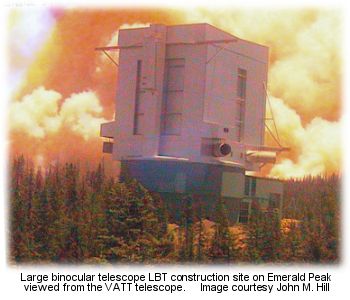 Firefighters were briefly pulled off the Nuttall Complex Friday, and about 10 firefighters had to deploy emergency shelters early in the afternoon. Officials had not yet determined why the deployment occurred, but fire activity had reportedly increased. All of the firefighters were reportedly okay, with no injuries. Firefighters were briefly pulled off the Nuttall Complex Friday, and about 10 firefighters had to deploy emergency shelters early in the afternoon. Officials had not yet determined why the deployment occurred, but fire activity had reportedly increased. All of the firefighters were reportedly okay, with no injuries.
Threatened structures include 25 homes, 10 commercial buildings, and two outbuildings.
The Gibson Fire, part of the Nuttall Complex, started June 22 and remained small, burning in steep terrain, until it took off yesterday. The fire more than doubled in size, making upslope runs; it's burning in a large stand of bug-killed trees.
Oltrogge's Type 1 team is managing the complex, which is about 15 miles southwest of Safford. It includes both the Nuttall and Gibson fires, and was 5 percent contained last night at 2,700 acres. The Nuttall Fire yesterday included extreme plume-dominated fire behavior, and the Gibson Fire was active with upslope runs and spotting. Crews are working on burnout operations and line construction on the Nuttall Fire, and the Gibson Fire will be monitored from the air. Structure protection is being put in place around the observatory.
Huge plumes of smoke were visible this morning from the Emerald Peak webcam.

FIVE AERO UNION TANKERS APPROVED TO FLYJULY 02 -- BOISE, IDAHO: Officials announced today that five heavy airtankers will return to service as early as next week. The decision follows the safety analysis conducted by DynCorp on eight Aero Union aircraft; inspections are continuing on the other three. The airtankers are all P-3 Orions.
"Being able to bring these assets back into the fire managers' toolbox is a real benefit," said BLM Director Kathleen Clarke.
On June 9 the Forest Service signed an agreement with Texas-based DynCorp Technical Services, the company that manages California's fleet of S-2 tankers, to analyze the airworthiness documentation provided by contractors at the request of the Forest Service.
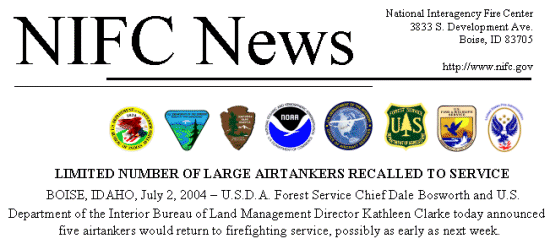 The Forest Service contracting unit at NIFC is currently negotiating a new contract with Aero Union for the airtankers, and the cost at this time is unknown. The negotiation process will take about a day, according to NIFC. The Forest Service fixed-wing specialist will travel over the weekend to Chico to check ride with the pilots and re-establish their qualifications. The aircraft are expected to be available for initial attack by Monday.
The Forest Service contracting unit at NIFC is currently negotiating a new contract with Aero Union for the airtankers, and the cost at this time is unknown. The negotiation process will take about a day, according to NIFC. The Forest Service fixed-wing specialist will travel over the weekend to Chico to check ride with the pilots and re-establish their qualifications. The aircraft are expected to be available for initial attack by Monday.
Potential for new wildfires will determine where the five tankers will be assigned, and their locations will be decided by the National MAC group.
DynCorp is currently examining the data packages from five other contractors, and will submit reports as they are completed.

USMC HASN'T PAID OLD SUPPRESSION BILLJULY 02 -- CARSON CITY, NV: A $10 million bill sent to the Marine Corps to cover the costs of fighting a 22,750-acre fire two years ago has still not been paid. The 2002 fire started near Pickel Meadows where trainees had set dozens of practice campfires. After sending the bill in January 2003, the Forest Service said negotiations had started with the Marines Corps over the costs for fighting the fire and doing associated post-fire rehab.
The Pickel Meadows base is on the Humboldt-Toiyabe National Forest, and the AP reported that existing agreements between the USMC and the USFS required the Defense Department to pay for any costs directly attributable to military training in the area.
The 2002 fire was about 20 miles south of a 940-acre fire that started earlier this week and evacuated a Marine Corps housing compound near the Pickel Meadows base. This year's fire was apparently ignited when four kids lit a cooking fire and embers blew into nearby brush. The Mono County district attorney's office is determining whether charges should be filed -- and another bill for firefighting could be sent out. Children of Marines were involved in the latest fire, and reimbursement costs would be billed to their parents rather than to the military.

ARIZONA: "WE'RE GIVING IT OUR BEST SHOT"JULY 01 -- PAYSON, AZ: Firefighters on the Willow Fire, the state's largest wildfire this year, are fighting without their biggest tool. Nearly two months after the cancellation of contracts for the nation's heavy airtanker fleet, wildfires like the one southwest of Payson are being fought differently, according to a report by the Arizona Republic.
Firefighters say they've had to shift strategies since the airtankers were pulled from service. SEATs and helicopters are being used more frequently -- and sooner -- in an attempt to fill the gap. They dumped hundreds of thousands of gallons on the Willow Fire Monday, but the fire is still nowhere near containment.
"If we had some heavy airtankers, it would help greatly," said Danny Kellogg, the U.S. Forest Service's Southern regional aviation operations specialist from Atlanta. "We're giving it our best shot with what we've got at our disposal."
A report in today's East Valley Tribune accuses federal officials of understating the crucial role of heavy airtankers since their contracts were canceled in May.
Jim "Mr. Arizona" Paxon, a Show Low resident and retired Forest Service fire information officer, has written letters to Congress and other decision makers urging them to rethink their decision. The airtankers are critical in fighting large wildfires and in preventing small fires from growing out of control, he wrote. Paxon said he was disappointed that officials have downplayed the airtankers' worth.
Forest Service officials have been assuring the public that the airtankers are not as effective as supporters believe, and that other aircraft being deployed are just as good. Bob Simpson, the Forest Service SEAT manager on the Willow Fire, for example, told a reporter this week that SEATs are "just as efficient for initial attack," and Kellogg said that heavy airtankers dropped only 20 percent of the retardant on fires over the past 10 years -- a mind-boggling but oft-repeated miscalcuation. Rob Crouch with with Fire-Trol in Phoenix said that was absolutely not correct. He says Fire-Trol supplies most of the retardant in the state, and that in recent years 80 percent of their retardant was used by heavy airtankers.
Other employees have been throwing around fuzzy math and misleading figures about the effectiveness of SEATs and helicopters.
In a recent email of canned "talking points" distributed to other employees, a Forest Service public affairs staffer told employees to be careful about their language when discussing airtanker issues. Rose Davis at NIFC made some good suggestions for accuracy, such as using "airtankers" rather than "bombers," but several other tips for "we say this and we don't say that" really put the spin on the issue. Airtankers, she wrote, should be referred to not as "vintage aircraft" but as "aging aircraft."
"We do not talk about capacity or gallonage of airtankers vs. helicopters or SEATs," was another suggestion. But the capacity of heavy airtankers is one of their key strengths. SEATs on the Willow Fire have been dropping 500 gallons per load. The typical heavy airtanker carries 2,000 to 3,000 gallons at a time.
The impact of removing the heavies from the firefighting "toolbox" will be evaluated over time, but some say the difference is already apparent.
Last week on Mount Graham, for example, lightning started several fires that were burning in an area including threatened and endangered species and a multi-million-dollar telescope facility. A heavy airtanker would have had a decent chance at snuffing those fires quickly, said Pete Gordon, deputy fire management officer for the Coronado National Forest. "If we had the P-3 available, it would have been very effective, I think, in getting through," Gordon said. "It was what it was designed to do."

MORE EVACUATIONS IN ALASKAJULY 01 -- FAIRBANKS, ALASKA: Hundreds of people, including about 200 workers at the state's largest gold mine, have left their homes and made their way to Fairbanks ahead of a 117,000-acre fire in Alaska's interior. Evacuations were ordered yesterday when winds picked up and pushed the fire toward homes. The Anchorage Daily News reported that firefighters and state troopers went door-to-door and telephoned residents. About half the workforce of the Fort Knox gold mine was evacuated, and mine officials shut down the $600 million operation.

BITTERROOT 'SHOTS UPDATEJULY 01 -- SOCORRO, NM: Three members of the Bitterroot Hotshot Crew remain hospitalized today after their crew vehicle was involved in a collision with an RV yesterday morning near Socorro.
The driver of the RV, Tim Schultz from Datil, New Mexico, was killed, and nine others were injured.
 Bitterroot Hotshot Nicole Lustig is in critical condition with head injuries, and Jared Bohrman is still in guarded condition with chest injuries. Both were airlifted to the UNM hospital and seven others were transported to the Socorro hospital. All but one of the seven have been released; firefighter Mike King remains in the hospital for observation. He was in good condition this morning. Bitterroot Hotshot Nicole Lustig is in critical condition with head injuries, and Jared Bohrman is still in guarded condition with chest injuries. Both were airlifted to the UNM hospital and seven others were transported to the Socorro hospital. All but one of the seven have been released; firefighter Mike King remains in the hospital for observation. He was in good condition this morning.
The other hospitalized crewmembers -- Jay Wood, Jude Waerig, Bill McMaster, Skylar Brown, Richard Griffin, and Lisa Kurtzhals -- have all been released. Travel arrangements for the crew are being made for their return to return to Montana.

CREWS BATTLING FIRE NEAR PAYSONJULY 01 -- PAYSON, AZ: Smoke from the Willow Fire filled the air yesterday, and Payson residents worried that the fire was growing, but officials say it remained at 32,000 acres throughout the day. Most of the smoke was from unburned islands of fuels within the fireline, according to a report by the Payson Roundup.
Buck Wickham with the Southwest Area Type 1 Incident Management Team said the fire is 5 percent contained, and though the team has not ruled out an evacuation, they say the chances are slim. Wickham said last night, though, that he couldn't say the same for the communities of Pine and Strawberry.
Crews are attempting to maintain the firebreak of the East Verde River between the fire and the two mountain communities north of Payson. "The fire has jumped the East Verde River several times," said Wickham, "but firefighters have been able to turn it back."
Crews have burned a two-mile firebreak around control lines, according to the Arizona Republic, and the fire's about four miles southwest of Payson. "There is quite a bit of distance between the burnout and the fire itself, so it will take a day or two for those to meet," said Ron Meyer, another fire information officer for the team. He said 17 buildings, including homes, barns and sheds, were still considered threatened by the fire.
West of Rye yesterday, two C-130 MAFFS units dropped retardant on a smaller fire that started when a bulldozer was cutting line. Wickham said in 35 years he'd never seen a fire started by a bulldozer.
Nearly 800 firefighters are on the Willow Fire, along with four SEATs, five helicopters, 28 engines, five water tenders, and a half dozen dozers.

HOTSHOTS INJURED IN VEHICLE ACCIDENT IN NEW MEXICOJUNE 30 -- SOCORRO, NM: A hotshot crew on their way to the Davenport Fire near Datil was involved in a vehicle accident with an RV near Socorro this morning. The driver of the RV was fatally injured.
Six of the Bitterroot Hotshots from Montana were injured and were transported to hospitals in Socorro and Albuquerque. Four of the 'shots were treated and released in nearby Socorro, and the other two were transported to Albuquerque where one is in critical conditon tonight and another is reportedly in guarded condition. There were other injuries in the RV, but details tonight are sketchy.
The Bitterroot Hotshots were reportedly on their way to their last shift on a fire on the nearby Cibola National Forest when the wreck occurred.
KRQE-TV reported that the crew buggy and an RV collided west of Socorro, killing the RV’s driver and injuring crewmembers in a head-on collision about 9:30 a.m.
The driver of the eastbound RV reportedly lost control of the vehicle after a tire blowout before the wreck, swerving into the westbound lane and slamming into the hotshots' vehicle. The first hotshot crew vehicle swerved and missed the RV, but the second one was hit head-on by the out-of-control RV. Two ambulances and a lifeguard helicopter responded to the wreck. The driver of the RV was pronounced dead at the scene of the crash.
The Davenport Fire was contained Monday at about 200 acres on the Cibola National Forest in west-central New Mexico.

7,000 LIGHTNING STRIKES IN NORTHERN CALIFORNIAJUNE 30 -- CHICO, CA: Lightning strikes over the north state Monday night touched off dozens of forest fires in northern California forests, but none of them got away. The Chico Enterprise-Record reported that more than 7,000 lightning strikes were recorded overnight between Monday and Tuesday, touching off small fires from Amador County to the Oregon border and west to Humboldt County.
The Plumas National Forest reported 40 to 45 small fires, but all were kept to under an acre. On the Shasta-Trinity, firefighters had 19 confirmed fires. The largest reached five acres; one fire north of Shasta Lake was attacked by smokejumpers. On the Mendocino, 12 fires were reported; the largest was a half-acre fire in the Yolla Bolly Wilderness. Smokejumpers were also committed on that fire.
For answers to all your questions about lightning (and then some), check out the lightning page from www.sky-fire.tv in Fort Collins, Colorado.

DOZENS EVACUATED IN ALASKAJUNE 30 -- FAIRBANKS, ALASKA: Dozens of people fled their homes and took refuge at a lodge northeast of Fairbanks after winds gusting to 30 mph whipped a wildfire in Alaska's Interior. State troopers closed the Steese Highway and asked residents to evacuate to the Chatanika Lodge about eight miles away. The AP reported that at least a dozen homes were threatened; a Type 2 team has been ordered.
Winds picked up in the afternoon and pushed the fire over a ridge and toward homes; an evacuation center was set up at a high school in Fairbanks.
The Boundary Fire grew substantially overnight, burning from about 75,000 acres to 117,000 acres, about 50 miles northeast of Fairbanks, said fire information officer Michelle Finch. The fire jumped the Steese Highway and was burning on both sides of the road; there is no estimate of containment.
Along with local residents, nearly 70 sled dogs also were evacuated, according to the coordination center at Fort Wainwright.
In northeast Alaska, the 143,564-acre Pingo Fire near Venetie remained about two miles from a village of about 300 people. Firefighters had built a 50-foot-wide fire break around the entire village and had pumps and hoses to the nearby Chandalar River in place. The Pingo Fire is part of the 259,309-acre Solstice Complex, which is being handled by Jandt's Type 2 team. Burning in black spruce and tundra, the complex also includes the Winter Trail, Sucker River, Black Currant River, Vundik Lake, Boulder Creek, and Sheenjek fires. Hot, dry and windy weather conditions are major concerns, with very active and extreme fire behavior reported on both the Pingo and Winter Trail fires.
Kurth's Type 2 team is on the Taylor Complex northwest of Tok; the complex includes the Wall Street, Billy Creek, Gardiner Creek, Big Creek, Chicken, and Porcupine fires and is reported at 239,457 acres. Heavy smoke is limiting mapping and visual confirmation of fire behavior and growth. Extreme fire behavior was observed on most fires with isolated torching and short uphill runs.
Southwest of Eagle in the Upper Yukon Zone, the American Summit Fire is in monitor status with resources being released. It's 20 percent contained at 15,000 acres. The 28,688-acre Camp Creek Fire, about 80 miles southeast of Fairbanks, has been active with torching; the fire was putting up multiple plumes of smoke yesterday and there's no estimate on containment.

LIVING IN THE STUPID ZONE:
HOMEOWNERS IN THE INTERFACEJUNE 29 -- SAN BERNARDINO, CA: Mountain residents for years have ducked accountability for building at-risk homes in the wildland/urban interface, and even after San Bernardino County last year endured its most devastating wildfire in history, none of the county's mountain communities require residents to protect their homes. Instead, says the San Bernardino Sun, they have put the onus on policymakers and firefighters.
In a new in-depth report on fires and floods and mudslides called "Unnatural Disasters," the Sun accuses public officials of misunderstanding, ignoring, or downplaying a known fire-flood cycle that has killed dozens of people and resulted in tremendous monetary losses that have been underwritten by U.S. taxpayers.
Rolland Crawford, chief of the Loma Linda Fire Department, says homeowners ignore fire-safe messages and the need for defensible space. "People say, 'I need to be among the trees. I didn't move to the desert,'" says Crawford.
The ever-expanding wildland/urban interface increases the fire danger for not just residents, but also natural resources in the surrounding foothills and mountain areas. And it substantially increases the risks that firefighters face in trying to defend homes from wildfire. Insurance companies require woodstove permits and flue inspections by fire personnel in states such as Oregon, and some insurance companies have recently begun requiring that homeowners reduce their exposure to fire danger by creating defensible space. But those are the exceptions -- in most areas, homeowners are free to build fire-prone homes with fire-prone landscaping in fire-prone areas, with no accountability.
"You can't tell people not to live there but they have to take the liability," said UC Riverside Professor Richard Minnich, an expert on forestry and fire ecology.
In some cases, government agencies have assessed and mapped fire and flood hazards and then failed to notify residents about the dangers they identified. Lytle Creek resident Randy Rose, 32, expressed surprise upon learning that government agencies had assessed hazards that directly affected his home -- and no one contacted him.
"If it's our house that's in jeopardy, that could be leveled, and all these agencies have been working together, why haven't they notified us?" asked Rose. "Where does the responsibility lie?"
But in other cases, residents were specifically told of the hazards and chose to ignore warnings. The manager of the KOA campground near Devore that was hit by a mudslide last year, for example, was warned about the dangers of flooding after last fall's fires denuded slopes above the campground. Yet no steps were taken to prepare for the tragedy that followed record rainfall in December.
The report by the Sun suggests that people perhaps consider fire an enemy that can be beaten, unlike other natural disasters. "There are no earthquake fighters, flood fighters, or tornado fighters," says the report. "The term 'firefighter' signifies an individual that not only can battle a blaze, but defeat it."
| 









 "It looks pretty cloudy and dark around here, not like it does on the postcards," said Sam Burgess, an 11-year-old tourist from Sydney, Australia, who was camping with his parents.
"It looks pretty cloudy and dark around here, not like it does on the postcards," said Sam Burgess, an 11-year-old tourist from Sydney, Australia, who was camping with his parents.

 Oltrogge's Type 1 team will hand off the complex to Winchester's Type 2 team this evening.
Oltrogge's Type 1 team will hand off the complex to Winchester's Type 2 team this evening.






 There are no "home bases" for the current reincarnation of airtanker contracts; the home base for Aero Union's P-3s will be Chico, California. A letter of inspection from DynCorp to the Forest Service was delayed by holiday mail slow-downs, which has temporarily stalled the return to service of two more P-3's owned by Aero Union.
There are no "home bases" for the current reincarnation of airtanker contracts; the home base for Aero Union's P-3s will be Chico, California. A letter of inspection from DynCorp to the Forest Service was delayed by holiday mail slow-downs, which has temporarily stalled the return to service of two more P-3's owned by Aero Union.


 Bitterroot Hotshot Nicole Lustig is in critical condition with head injuries, and Jared Bohrman is still in guarded condition with chest injuries. Both were airlifted to the UNM hospital and seven others were transported to the Socorro hospital. All but one of the seven have been released; firefighter Mike King remains in the hospital for observation. He was in good condition this morning.
Bitterroot Hotshot Nicole Lustig is in critical condition with head injuries, and Jared Bohrman is still in guarded condition with chest injuries. Both were airlifted to the UNM hospital and seven others were transported to the Socorro hospital. All but one of the seven have been released; firefighter Mike King remains in the hospital for observation. He was in good condition this morning.